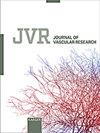利用超声矢量血流成像评估颈动脉分叉处壁剪应力和血流湍流的特征及相关性
IF 1.8
4区 医学
Q3 PERIPHERAL VASCULAR DISEASE
引用次数: 0
摘要
摘要:本研究的目的是基于超声矢量流成像(V flow)评估健康成人颈动脉分叉的壁剪应力(WSS)和血流湍流(Tur)的特征和正常值,以及它们之间的关系。方法:颈内动脉和颈外动脉初始段[IICA和IECA]的最大和平均WSS和turr值;应用超声V血流功能对56例健康成人颈总动脉远段[DCCA]前、后壁进行了超声V血流功能测定。进一步探讨了平均WSS与turr的关系。结果:IICA、IECA、DCCA组WSS平均值分别为0.71 Pa、0.86 Pa、0.96 Pa (IICA < IECA < DCCA, p < 0.05)。IICA、IECA和DCCA的平均Tur值分别为13.85%、5.46%和4.17% (IICA > IECA > DCCA, p < 0.05)。选择截断值(WSS = 0.4 Pa), WSS截断值<0.4 Pa组的Tur值显著高于WSS截断值≥0.4 Pa组(p < 0.01)。结论:WSS与turr呈中度负相关,可用于颈动脉分叉的定量评价,可作为临床研究中早期发现颈动脉粥样硬化的一种潜在的双参数工具。本文章由计算机程序翻译,如有差异,请以英文原文为准。
Characteristics and Correlations of Wall Shear Stress and Flow Turbulence in the Carotid Bifurcation Evaluated Using an Ultrasound Vector Flow Imaging
Introduction: The aim of the study was to evaluate characteristics and provide the normal values of wall shear stress (WSS) and flow turbulence (Tur), and the relationship between them in the carotid bifurcation based on an ultrasound vector flow imaging (V Flow) in healthy adults. Methods: Max and mean WSS and Tur values at three segments (initial segments of internal and external carotid arteries [IICA and IECA]; distal segment of common carotid artery [DCCA]), both in anterior and posterior walls, were successfully obtained in 56 healthy adults, using ultrasound V Flow function. Relationship between mean WSS and Tur was further explored. Results: The mean WSS value was 0.71 Pa, 0.86 Pa, and 0.96 Pa at IICA, IECA, and DCCA, respectively (IICA < IECA < DCCA, p < 0.05). The mean Tur value was 13.85%, 5.46%, and 4.17% at IICA, IECA, and DCCA, respectively (IICA > IECA > DCCA, p < 0.05). A cutoff value (WSS = 0.4 Pa) was selected and Tur values were significantly higher in group with WSS cutoff value <0.4 Pa than group with WSS cutoff value ≥0.4 Pa (p < 0.01). Conclusion: WSS and Tur are moderately negatively correlated, which can be used in the quantitative evaluation of carotid bifurcation and could be a potential dual-parameter tool in the clinical research for early detection of carotid atherosclerosis.
求助全文
通过发布文献求助,成功后即可免费获取论文全文。
去求助
来源期刊

Journal of Vascular Research
医学-生理学
CiteScore
3.40
自引率
0.00%
发文量
25
审稿时长
>12 weeks
期刊介绍:
The ''Journal of Vascular Research'' publishes original articles and reviews of scientific excellence in vascular and microvascular biology, physiology and pathophysiology. The scope of the journal covers a broad spectrum of vascular and lymphatic research, including vascular structure, vascular function, haemodynamics, mechanics, cell signalling, intercellular communication, growth and differentiation. JVR''s ''Vascular Update'' series regularly presents state-of-the-art reviews on hot topics in vascular biology. Manuscript processing times are, consistent with stringent review, kept as short as possible due to electronic submission. All articles are published online first, ensuring rapid publication. The ''Journal of Vascular Research'' is the official journal of the European Society for Microcirculation. A biennial prize is awarded to the authors of the best paper published in the journal over the previous two years, thus encouraging young scientists working in the exciting field of vascular biology to publish their findings.
 求助内容:
求助内容: 应助结果提醒方式:
应助结果提醒方式:


